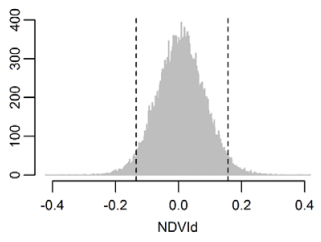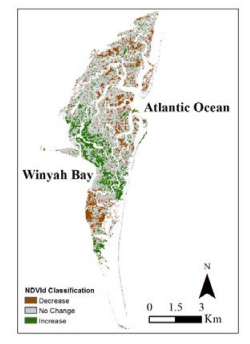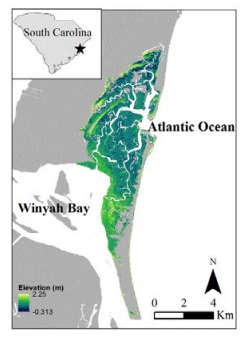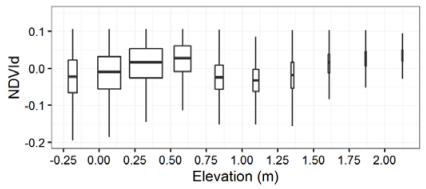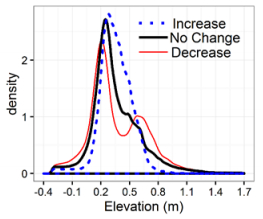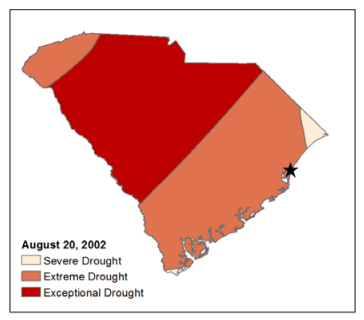1. Introduction
Salt marshes are ecologic ally important and provide an array of ecosystem services such as storm-surge protection, carbon storage, improvement of water quality, and habitat for wildlife [1,2]. Within the east and gulf coasts of the United States, hurricanes and sea-level rise are two large threats to human populations and infrastructure. The salt marshes in these regions are particularly valuable in protecting communities against these environmental events. With climate change projections, sea-level rise will continue and hurricane intensity is predicted to increase [1,3]. Threats to salt marsh health arise with development, pollution, and environmental changes. One such phenomenon that occurs on a global scale is marsh dieback (also known as brown marsh), where periodically large areas of smooth cordgrass, Spartina alterniflora, suddenly thin in coverage or die, resulting in a sparsely vegetated area or transformation into a mudflat [4,5,6]. Though typically marsh dieback impacts S. alterniflora, other salt marsh plants such as Juncus roemerianus, J. geradii, Distichlis spicata, S. patens, and S. phenomena are also affected [5,7,8]. Dieback events can be quite large, such as an event in Louisiana which impacted more than 100 000 ha of salt marsh habitat [9]. Regions impacted by marsh dieback often grow back, usually over a period of years and ecosystem services are degraded during this period [6]. The exact cause of marsh dieback is unclear, but herbivory, sulphide toxicity, elevated salinity and drought are believed to contribute to the dieback in some regions [6,8,9].
Researchers have conducted both field campaigns and remote sensing analysis to better understand the causes and extent of marsh dieback. In Louisiana, several researchers conducted remote sensing analysis to detect biophysical changes within dieback regions. One such study analysed the changes in leaf reflectance in blue, green, red, near infrared (NIR) wavelengths using multispectral sensors in various dieback and healthy regions. They found the band ratio NIR/green was most effective for monitoring impacts [4]. Another study used satellite data from Landsat Thematic Mapper (ETM+), Satellite Pour l'Observation de la Terre (SPOT), and NASA uninhabited aerial vehicle synthetic aperture radar (UAVSAR) to map marsh dieback during the 2008 event [10]. They took a slightly different approach from Ramsey and Rangoonwala [4] and estimated biomass changes within dieback regions using before and after imagery from the same region. They determined that UAVSAR'S horizontally sent and vertically received (HV) backscatter was the best polarization for detecting changes within marsh biomass. They also determined that, for SPOT and ETM+, the band ratio of NIR/red was an effective vegetation index to use for change detection mapping of marsh extent. This vegetation index was also used for assessing S. alterniflora health [11]. Within Georgia, a study using geographic object-based image analysis with multispectral very high resolution (0.3 m) data to classify marsh coverage within a dieback affected region [12]. The study determined that using both multi-scales and texture data when segmenting an image for land type classification improved the accuracy of image classification.
South Carolina has roughly 344 500 acres of salt marsh habitat, and is home to the largest expanse of salt marsh of any state on the U.S. East Coast [13]. Field studies of marsh dieback events in South Carolina have focused on the causes. With herbivory experiments, Kiehn and Morris [14] found that periwinkle snail densities, which primarily forage on the epiphytes on leaves of S. alterniflora, causing leaf damage [15], had no significant relationship with marsh primary production on permanent plots at North Inlet, SC. Researchers also used the Palmer drought severity index to assess the importance of drought. Though it is not a definite link to dieback events, several locations that experienced drought subsequently experienced a dieback event [8,16]. Agrelius [17] examined methylation of S. alterniflora DNA, an epigenetic process affecting fitness, but did not find evidence for a change in global methylation as the cause of brown marsh at North Inlet estuary, SC. DNA is methylated when a methyl group is added to DNA; this helps control gene expression, but may also reduce stress tolerance [17].
Despite these studies, there is no spatial analysis of marsh dieback within South Carolina, which might help determine causes of dieback events. This study aims to map the extent of marsh dieback during a 2001–2003 event at North Inlet estuary, South Carolina. This event also was coincident with widespread dieback within an adjacent state (Georgia) that started in 2001/2002 and was the largest dieback on record in that state, impacting the whole coast [5,6]. The dieback region was still evident between 2003 and 2005, after which a slow recovery was observed [5,18]. Using satellite-extracted vegetation indices, the present study maps the continuous distribution of marsh stress in North Inlet estuary. The work was undertaken to assess the spatial extent of stress to marsh vegetation within the estuary during this period, which we believe can add new information about the causes of marsh dieback and stress in general. This spatial information is beneficial for understanding the extent of marsh dieback within South Carolina and regionally, and should be useful for marsh management and conservation efforts.
2. Methods
2.1. Study Area
The study area is North Inlet located near Georgetown, South Carolina (Figure 1). North inlet is bordered by the Atlantic Ocean on the east and Winyah Bay to the west and south. Within this estuary, researchers have observed that at least two locations were affected by marsh dieback during the 2001–2003 event [8,16].
North Inlet experiences a semi-diurnal tidal regime meaning there are two high and two low tides each lunar day (24.8 hours). North Inlet is dominated by a monoculture of native S. alterniflora living between approximately mean sea level and mean higher high water, or the mean of the higher of the two daily high tides. The species has a wide range of salinity tolerances and usually is found in low lying regions with salinities between 2 and 35 psu. The high marsh is irregularly flooded and S. alterniflora is typically shorter than the stands found in the low marsh [13]. Precipitation averages between 127 to 132 cm per year, with maxima in August and minima in November to April. Average coastal temperatures vary from 9–11 ℃ in the winter to 25–27 ℃ during the summer, though average minimum January temperatures are 1.89 ℃ and average maximum summer temperatures are 32.7 ℃ [19].
The NOAA national estuarine research reserve system (NERRS) provides land use land cover data created from high resolution orthoimagery and field verification [20]. For the study region we only included areas classified by the research reserve as wetlands with emergent vegetation dominated by S. alterniflora and non-vegetated mudflats around the tidal creeks.
2.2. Datasets and Pre-processing
Five Landsat images were utilized in this study: one Landsat 7 ETM+ scene acquired on September 4,1999 and four Landsat 5 Thematic Mapper (TM) scenes acquired on September 13,1996, September 24,2003, September 19,2004, and September 16,2006. All images were atmospherically corrected surface reflectance products downloaded from USGS data clearinghouse. USGS uses the Landsat ecosystem disturbance adaptive processing system (LEDAPS) to create on demand surface reflectance products created using the second simulation of a satellite signal in the solar spectrum (6S) radiative transfer model. Several other researchers successfully used LEDAPS for surface reflectance within coastal marshes [21,22,23]. Images were either cloud free or had small cloud patches masked out. We also utilized the National Oceanic and Atmospheric Administration's tides and currents website (https://tidesandcurrents.noaa.gov) to select images collected during lower tides which reduces influence of tidal submergence of plants on vegetation indices (Table 1). We used the 1999 Landsat scene as the pre dieback image and the 2003 Landsat scene as the post dieback image. The 1996,2004, and 2006 Landsat scenes provided additional imagery to further assess spectral indices before and after the dieback period, and insure the spectral change is not just happenstance.
Table 1. Date and time of Landsat data acquisition and associated tidal height (m) above mean sea level.
| Date |
Time (GMT) |
Tidal height above mean sea level (m) |
| Sep. 13,1996 |
15:05:53 |
0.229 |
| Sep. 05,1999 |
15:47:09 |
–0.464 |
| Sep. 24,2003 |
15:31:51 |
–0.471 |
| Sep. 19,2004 |
15:31:58 |
0.587 |
| Sep. 16,2006 |
15:48:01 |
–0.229 |
Axillary datasets include high spatial resolution (0.25 m) digital orthographic photos from 2003 and 0.7 m multispectral airborne data acquisition and registration (ADAR) imagery from 2000 available from South Carolina's Department of Natural resources (refer to reference [24] for a detailed description of ADAR imagery). The 2000 image covers the 24 entire marsh while the 2003 photo covers a majority of the marsh. Resolutions of these aerial images are high enough to visually detect the change of salt marshes between 2000 and 2003, and therefore, they serve as validation sources to the satellite-extracted marsh change in this study. Visual interpretation of high resolution photos has proven effective in past studies [25,26]. We randomly generated 100 points within the marsh and removed points that were difficult to classify due to clouds or cloud shadows, leaving 84 points as ground truthing samples. Furthermore, we obtained a 2007 light detecting and ranging (LiDAR) digital elevation model of North Inlet, through a nondisclosure agreement with Georgetown County, which gave us a high resolution (5 m) dataset of elevation relative to North American Vertical Datum of 1988.
2.3. Change Detection and Accuracy Assessment
Histogram match was performed with the histMatch function within the open source R statistical program to reduce the radiometric noises between the two Landsat images in 1999 and 2003 [27]. Histogram matching forces the histogram shape of one data set to match another, but the range of values remains the same. To determine plant greenness and extent we used the normalized difference vegetation index (NDVI), this vegetation index is widely used and is successful in measuring change within vegetation [25,26,28]
The NDVI for 1999 and 2003 along with the NDVI difference (NDVId) were calculated using the following equations:
where NIR is the spectral reflectance of the near infrared band (wavelength 0.77–0.90 µm) and, RED is that of red band (wavelength 0.63–0.69 µm).
NDVI values range from –1 to 1. Water usually has NDVI less than 0 and healthy vegetation has high values close to 1. Since marsh dieback causes vegetation to thin or completely dieoff, NDVI values should reflect this decreased vegetation change. The resulting NDVId values follow a normal distribution with a mean close to zero (Figure 2).
Thresholding approaches have been commonly applied in change detection analysis [28,29], where the histogram of the change image was used to identify levels of changes in vegetation. Here we adopt the same method to statistically determine marsh changes. Specifically, the following thresholds were used:
• Marsh decrease: NDVId < −σ
• No change: −σ < NDVId < σ
• Marsh increase: NDVId > σ
where σ is standard deviation from the mean NDVId values. Following the method in Wang et al. [29], we use the same threshold of one standard deviation to represent vegetation change (in either direction). At a given pixel, when the absolute change of NDVId is less than one standard deviation, we assume that the change is not statistically significant and assign it as no change. In Figure 3, areas with negative NDVId values are considered marsh dieback, while those with positive values are increased vegetated regions.
The error matrix approach was then applied for accuracy assessment of the NDVId-based change map. Since each Landsat pixel is 30 meters, we created a 90 meter buffer around each of the 84 ground truthing points and visually observed if the NDVId within the majority of the buffered region increased, decreased or stayed no change. We then assessed the accuracies of the three categories.
Lastly, we created 110 random points within the areas classified as dieback (NDVI decrease) and increase. A total of 50 points were within the increase area and 60 were within the dieback area. We then extracted the NDVI values for each year (1996,1999,2003,2004 and 2006) for each point. We further separated the points by dieback experienced within the northern portion of the marsh and dieback within the southern portion of the marsh. NDVI values for each of the three categories were then plotted for each year, so we can observe the changes in NDVI values over time. We used this method to further validate the inferences made within the study.
3. Results and Discussion
In the error matrix (Table 2), we classified 27 points categorized by the NDVId assessment as dieback, 26 as increase, and 31 as no change (Table 2). This yielded an overall accuracy of 76.2% while the no change category had the highest user's accuracy and the dieback category had the highest producer's accuracy. The conditional kappa values were 0.69, 0.51 and 0.74 for the dieback, increase, and no change categories, respectively. The conditional kappa value ranges between –1 and 1 and gives an indication of individual category agreement [30]. As revealed in the table, the low conditional kappa of the increase category was related to its high confusion with the no change category. For marsh dieback, a conditional kappa of about 0.7 indicated that our NDVId-based change detection method fairly identified the dieback marshes in the study area. The detection of regions with marsh increase had lower accuracy, and was occasionally classified as no change. The NDVI derived classification for marsh increase had a higher misclassification category of no change. This could be due to variations in plant growth within the two Landsat images. The satellite image from 2003 was taken 20 days later in the growing season than the 1999 image, both in September, but at a time of year when the plants should be at peak greenness, followed soon after by senescence [31]. The timing of plant senescence can vary from year to year which may influence the NDVI values, and without field verification it is difficult to know if the degree of senescence is equal in each satellite image.
Table 2. Error matrix for the NDVI derived and visually derived change of marsh growth between 1999 and 2003 for North Inlet.
| Visual Classification |
| NDVI Classification |
Dieback |
Increase |
No Change |
Count |
User's Accuracy |
| Dieback |
21 |
0 |
6 |
27 |
77.8% |
| Increase |
0 |
16 |
10 |
26 |
61.5% |
| No Change |
2 |
2 |
27 |
31 |
87.1% |
| Count |
23 |
18 |
43 |
84 |
|
| Producer's Accuracy |
91.3% |
88.9% |
62.8% |
|
Total Accuracy 76.2% |
The zones within the marsh that were classified as no change, vegetation increase, and decline in vegetation are spatially represented in Figure 3. The region with the largest amount of marsh increase was across the southwest of North Inlet adjacent to Winyah Bay. The northern and southern ends of North Inlet experienced the largest decrease in vegetation (Figure 3). Though the elevation range within the marsh is small (Figure 4), it is apparent the southern end of the marsh has the highest elevation while the northern end has the lowest. Visually, the areas with both the highest and lowest elevations experienced the most pronounced decline in vegetation. Plotting the NDVId versus elevation further shows that areas within the highest and lowest elevation had a decline in NDVI between 1999 and 2003 (Figure 5). The width of each of the bars in the plot are scaled based on the number of data points within each category, this shows that the majority of study area falls within elevations between –0.25 m and 1.5 m. At elevations greater than 1.5 meters the NDVId did increase from 1999 to 2003 but there is markedly less area of interest within that elevation range. The mid elevations had the greatest amount of NDVId increase occurrences, which indicates that the plants living within the mid elevations are the healthiest and less impacted by environmental stressors.
The mean elevation within North Inlet is 37 cm above sea level and the southern end of the marsh is at a slightly higher elevation than the north end [24] (Figure 4). The small changes in elevation most likely influence the health of the marsh; a past study at North Inlet indicated that the marsh is not keeping up with sea-level rise which would result in vegetation decline at the lower elevation areas. S. alterniflora grown at low elevations have the lowest above ground biomass production which traps less sediment and does not facilitate vertical sediment accretion as well as higher biomass areas [32,33]. However, climate anomalies can produce interannual changes in mean summer sea level of 15 cm [32]; during 2003 the mean sea level was –3.5 cm while the mean sea level for 1999 was 2.6 cm (https://tidesandcurrents.noaa.gov). Another explanation for the decline in marsh health within lower elevations is due to increased toxin accumulation or hypoxia. Hydrogen sulphide is a by-product of microbial activity within anoxic conditions such as those within salt marshes. At high concentrations, hydrogen sulphide becomes toxic to plants and limits biomass production [34]. Tidal flushing and drainage may mitigate the negative effects of hydrogen sulphide and varies with relative elevation. At lower elevations the marsh experiences more tidal flushing but less drainage, leading to higher and growth-limiting accumulations of this toxin. It is likely that the plants suffering from the dieback event suffered from increased hypoxia reducing their overall fitness, which is highlighted by the overall decline in NDVId and increased frequency of marsh decline areas at lower elevations (Figures 5 and 6).
In contrast, regions that are at higher elevation may experience hypersalinity and osmotic stress during years of drought and lower sea level which could lead to plant death. Hypersalinity results from the minimal flow of fresh water into North Inlet, evapotranspiration concentrating the salt in sediments, and tidal flushing being less pronounced in higher elevations than lower elevations. Within South Carolina much of the state was in a drought during both 2001 and 2002 (Figure 7). Osmotic stress from hypersalinity likely impacted the vegetation within North Inlet within the higher elevation areas. This hypothesis is supported by the increased frequency of vegetation loss in higher elevations (Figure 6). Figure 6 also illustrates that plants within mid elevations experienced the least amount of vegetation decline. The plants within the mid elevations are exposed hypoxia and hypersalinity at reduced rates and are overall less stressed than plants at higher and lower elevations.
The trend in NDVI over time further highlights the results from this study (Figure 8). The NDVI values prior to the marsh dieback event were all similar. NDVI declined in both northern and southern areas during the drought, and was within the northern section of the marsh, which also is located within the lower marsh elevations (Figure 8b). Furthermore, there was a significant (p < 0.0001) declining trend in NDVI values after the brown marsh event within the northern area. This indicates that the marsh situated at the lowest elevation is most prone to declining health. The area classified with increased NDVI in 2003 had higher NDVI values than both the years before and after the marsh dieback event. This indicates that the factors contributing to the dieback event likely had a positive influence in vegetation growth within other areas of the marsh (Figure 8c).
It is important to note a few limitations within this study. Landsat imagery only has a 30 meter spatial resolution, making it difficult to analyse landscape changes at a smaller scale. But a significant decrease in NDVI between the two dates is detectable within a Landsat pixel. In addition, all areas within this study that show a decrease in vegetation were classified as marsh dieback. Though the area classified as marsh dieback may not have a total loss in vegetation, there was still a marked decline in vegetation health or coverage which resulted in that area being classified as marsh dieback. Furthermore, thinning of vegetation is also a symptom of marsh dieback. Given these limitations, the study still highlights the locations of decreased and increased vegetation and improves our knowledge about the spatial distribution of vegetation change. Using the spatial data the potential causes of the event are further understood. Results from this study also highlight the importance of elevation on controlling the health of a marsh. When assessing the extent of future brown marsh events researchers or land managers should focus on the locations that are at the minimum and maximum elevations within the marsh.
4. Conclusion
The Landsat-extracted NDVI change between 1999 and 2003 highlights regions of growth and decline within the North Inlet estuary. The overall accuracy of marsh change reached 76% and the conditional kappa value of marsh dieback was 0.7. The northern portion of the marsh experienced the largest thinning or dieback while the southern end of marsh region near the northern part of Winyah Bay experienced the largest increase in greenness. Slight elevation change was a key controller of health within the marsh. The dieback area occurred less frequently within the mid elevations of the marsh, while high elevations experienced increased dieback likely linked to hypersalinity and the low elevations within the marsh experienced increased dieback area likely caused by hypoxia.
Acknowledgments
This work was supported by the National Science Foundation Division of Environmental Biology under grant number 1052636 and supported by the South Carolina Sea Grant Consortium with NOAA financial assistance number NA10OAR4170088.
Conflict of Interest
We declare that there is no conflict of interest in this paper.









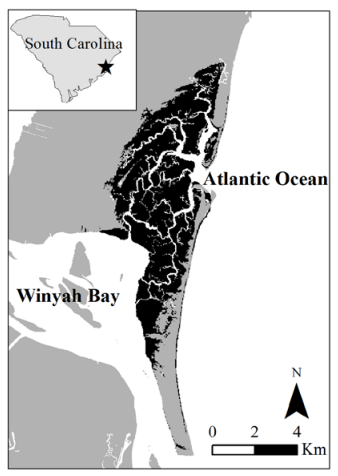
 DownLoad:
DownLoad: 